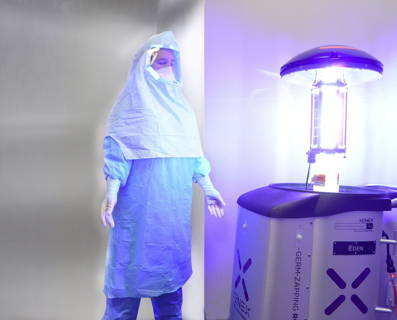 Cleanzine: your weekly cleaning and hygiene industry newsletter 17th July 2025 Issue no. 1171
Cleanzine: your weekly cleaning and hygiene industry newsletter 17th July 2025 Issue no. 1171
Your industry news - first
The original and best - for over 20 years!
We strongly recommend viewing Cleanzine full size in your web browser. Click our masthead above to visit our website version.
Ebola highlights importance of infection prevention
 The arrival of the Ebola virus on new continents has served as a wake-up call for infection prevention in hospitals worldwide. Patients suspected of or diagnosed with an Ebola virus infection pose a risk for healthcare workers, patients and visitors.
The arrival of the Ebola virus on new continents has served as a wake-up call for infection prevention in hospitals worldwide. Patients suspected of or diagnosed with an Ebola virus infection pose a risk for healthcare workers, patients and visitors.
This includes the risk of transmission of Ebola within the healthcare environment; and the perception of risk, which could lead hospital staff to refuse to work with patients and discourage patients from coming to the hospital for treatment.
Each risk requires hospitals to assure both healthcare workers and the public that hospitals are clean and safe, and protocols are in place to effectively disinfect the healthcare facility, including the use of state-of-the art technology.
In the US, in support of recent Centers for Disease Control and Prevention (CDC) guidelines, and in response to President Obama's call to contain the Ebola virus, Xenex Disinfection Services has created protocols that allow for the Full Spectrum ultraviolet disinfection of multiple areas within a healthcare facility and the disinfection of PPE (personal protective equipment) prior to doffing (removal) by individual healthcare workers.
The protocol includes disinfection of all areas where an infected patient will be transported or treated, as well as specific protocols designed to protect hospital staff, particularly during the doffing of PPE that may have become contaminated while treating a patient.
"Hospitals across the country may handle suspected Ebola cases so it's critical for every facility to have a comprehensive plan in place to ensure the safety of healthcare workers, patients and the general public," says Dr. Mark Stibich, co-founder and Chief Scientific Officer of Xenex. "We created this Ebola protocol using our experience in over 250 hospitals, as well as laboratory data on the effectiveness of Xenex's germ-zapping robots on Ebola-type viruses.
"Patients, communities, and hospital employees want reassurance their hospital is utilising the most advanced technology available to protect them."
The addition of Xenex's pulsed xenon UV light disinfection technology to infection prevention protocols will reduce the environmental risk of transmission of the Ebola virus. Xenex germ-zapping robots produce high-intensity UV light which destroys the microorganisms that cause healthcare associated infections such as Clostridium difficile, Methicillin-resistant Staphylococcus aureus, Enterovirus D68, VRE and Ebola.
Capable of disinfecting a typical patient/procedure room in 5-10 minutes, the Xenex robot is easily integrated into a hospital's infection prevention programme to protect against not only the Ebola virus but against all the other dangerous superbugs prevalent in hospitals today.
For healthcare workers, Xenex recommends the PPE worn by the healthcare workers be exposed to the Xenex germ-zapping robot for a period of five minutes prior to its removal. This will disinfect the PPE to reduce the risk of transmission of Ebola to the healthcare worker during the doffing process, which is known to pose a risk to healthcare workers.
Xenex has tested the disinfection coverage this provides for workers, while confirming that the PPE will keep workers safe from the UV light produced by a Xenex robot.
The protocol only applies to the Xenex pulsed xenon UV room disinfection system germ-zapping robots. Xenex has developed a patent-pending system to optimise the pre-doffing disinfection, making it faster, more thorough and easier on the healthcare worker.
The Xenex germ-zapping robot works by pulsing xenon, an inert gas, twice a second at high intensity in a xenon ultraviolet flashlamp. This produces ultraviolet C (UVC), which penetrates the cell walls of microorganisms including bacteria, viruses, mould, fungus and spores. Their DNA is instantly fused so that they are unable to reproduce or mutate, effectively killing them on surfaces and in the air without contact or chemicals.
Xenex robots are considerably faster, safer and 'greener' than other automated cleaning and infection control methods, including toxic mercury UV and hydrogen peroxide-based systems, which can take multiple hours to achieve the same level of disinfection.
Because of its use of pulsed xenon, Xenex robots are hundreds of times more powerful and intense than mercury UV systems, meaning that they can disinfect healthcare facilities in a fraction of the time it takes for mercury bulb devices. Pulsed xenon emits high intensity UVC light across a broad germicidal spectrum (200-280 nanometers versus the single spectrum of 253.7 nanometers for mercury bulbs). This broad germicidal spectrum enables Xenex devices to eliminate a wider range of pathogens at a much faster rate than mercury devices. The Xenex germ-zapping robot can disinfect a typical patient/procedure room in 5 - 10 minutes, as demonstrated in multiple peer-reviewed published studies.
"The risk of a patient in a US hospital contracting the Ebola virus is low. The risk is much higher for a patient to contract one of the superbugs like C.diff that are prevalent in the US right now - which is why forward-thinking hospitals have invested in technology to keep their patients safe," says Morris Miller, CEO of Xenex. "We are hopeful that the current attention on the Ebola virus will lead to substantial investments in infection control, including advanced technologies like our germ-zapping robots."
30th October 2014







